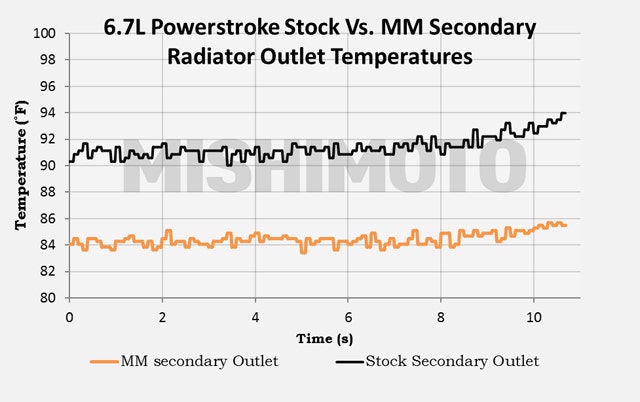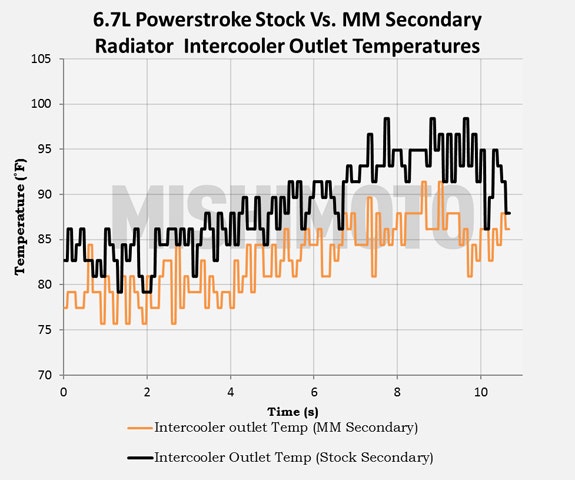![Love Is in the [Charge] Air - Secondary Radiator R&D, Part 2: Prototype Testing and Data](https://www.mishimoto.com/media/magefan_blog/2016/07/015-2-1.jpg)
Love Is in the [Charge] Air - Secondary Radiator R&D, Part 2: Prototype Testing and Data
Last time, we took a look at the unique design of the Ford 6.7 secondary Super Duty radiator and its accompanying thermostats. Our last post was only about two weeks ago, but I come bearing some good news - plus, great things come in twos.
Why does my primary rad need a companion?
As a recap, this heat exchanger, found in 2011+ Ford Super Duty trucks, works as an integral part of a mostly independent secondary cooling system that manages many of the truck's auxiliary cooling needs, including those of the liquid-to-liquid charge air cooler. Cooling these engine components more efficiently should not only prolong their useful lives, but also may make for some nice performance benefits if coupled with a tune - who doesn't love colder charge air?
The secondary system allows the primary radiator to more exclusively and efficiently cool the torquey Power Stroke motors found in these trucks. For more information on the intricacies of this complex, clever system (and the benefits of upgrading it), check out our first post on the R&D process for our secondary Ford 6.7 Super Duty radiator.
The Dirty Details
To improve the heat exchanger's cooling ability, we made several important improvements to the construction and design of the radiator. For starters, the core itself is thicker than the factory core by about nineteen percent. This allows for coolant to be distributed through a wider network of cooling tubes, amounting to a total increase in fin area of twenty-seven percent over the factory Super Duty radiator.

Thermostat housing mount on the passenger side end-tank of our Super Duty radiator.
The increased core thickness also allows for a decreased fin height, meaning that cooling tubes can fill the space more densely than they do on the factory unit while retaining at least the same level of heat dissipation to the atmosphere, increasing the total effective cooling area. In our design, the thicker core allows for a sixteen percent increase in total cooling tube surface area.

Mishimoto's secondary system Super Duty radiator.
Additionally, here are some photos of the thermostat housings we designed to retain the hybrid two/three row functionality of the heat exchanger.

Note: though the prototype housings are billet aluminum, the production version will be cast, and the finish will appear more brushed/matte than what is pictured.
The thermostat housings bolt to the sides of the Super Duty radiator. Here is the driver's side view.

Mishimoto's secondary system Super Duty radiator, driver's side view.
Testing the Waters
To measure the magnitude of the performance increases gained with our upgraded heat exchanger, we installed our secondary Ford 6.7 radiator on a 2011 F-250 in order to do some testing on our Dyno-Jet dynamometer. Ambient temperatures in the testing environment were about 65 degrees Fahrenheit, and we tested both the factory Ford 6.7 secondary radiator and the Mishimoto 6.7 secondary radiator under the same conditions and in the same session. We used AEM temperature sensors to monitor the inlet/outlet temperatures of both the coolant in the secondary radiator and the charge air in the intercooler piping (inlet on the hot side, outlet on the cold side). Measurements were taken for each sensor location once the truck shifted into sixth gear.

Our 6.7 F-250 Super Duty test vehicle on the dyno.
Talk Data to Me
Having run the truck on the dyno through numerous runs with both radiators, we were able to consistently observe a seven degree drop in outlet temperatures with the Mishimoto secondary radiator, which affected a six degree drop in charge air temperatures as compared to the factory Super Duty radiator. Not too shabby!


A Match Made in Heaven
One of the design objectives that we tout very proudly and adhere to on just about everything we make is our commitment to ensuring that each part is a direct-fit alternative to the factory part it replaces. Our Ford 6.7 radiator in the secondary system is no exception, and will hit it off quite well with your factory primary radiator. Of course, it has been designed also to find love at first site with our own Mishimoto 6.7 primary radiator. Check out some photos of our secondary radiator intimately snuggled before our Mishimoto primary radiator in the front of a 2011 F-250 test vehicle.

The front of our 6.7 Super Duty with Mishimoto's primary and secondary system radiators installed.

Driver's side view of our 6.7 Super Duty with Mishimoto's primary and secondary system radiators installed.

Driver's side view of our 6.7 Super Duty with Mishimoto's primary and secondary system radiators installed. The thermostat housing is pictured near the bottom.

Passenger side view of our 6.7 Super Duty with Mishimoto's primary and secondary system radiators installed. The thermostat housing is pictured near the middle.
But when can I get one?
I imagine it gets awkward when you walk into the garage in the morning only to find your primary Super Duty radiator quietly listening to James Blunt and perusing RadMatch.com - no one wants to be unhappy with their partner. You can tell your primary rad, however, to stop whining and put on some real music, because you can make its dreams come true today! Beginning right now, you can be the ultimate wingman for your cooling system and order the Mishimoto 6.7 Secondary Radiator at our limited-time discounted pre-sale price.
Thanks for reading!
-Gardiner











